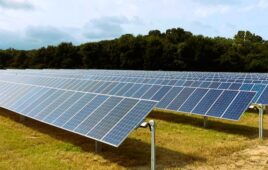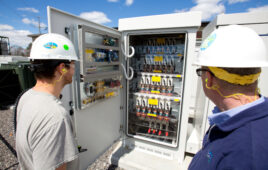While most inverter suppliers offer monitoring services, sometimes a more granular platform is necessary.

A screenshot of Solar Data System’s Solar-Log monitoring platform for residential and commercial plants. (click to enlarge)
Most major inverter manufacturers offer their own monitoring for installers to purchase. Along with the actual hardware, monitoring is an essential part of the value proposition for inverter supplier solutions.
“The monitoring services and software that inverter manufacturers provide is typically—especially with some of the bigger name manufacturers—readily available and easy to understand with a lot of information for both the installer and end-use customer,” said Michele Ladd, commercial and utility sales engineer at solar equipment distributor Renvu.
Inverter-supplied monitoring solutions have features that let installers view multiple systems and track performance, diagnose failures, remotely update inverters and commission systems. End-users can also use these solutions to see their system’s performance. Some inverter suppliers even offer monitoring that can accommodate systems with battery storage.
“For some applications, that’s going to be the [only] information you need,” Ladd said.
When inverter-supplied monitoring isn’t enough
However, there are applications that require more granular monitoring than what inverter supplier platforms can provide.
Maybe an industrial solar site wants to know how much power it’s using, when it’s using it and whether it’s coming from the solar system or the grid. Maybe there are regulations capping how much excess power can be placed on the grid, or specific data is required to qualify for incentives. Perhaps a customer wants to see how much power specific loads, like a refrigerator or HVAC system, are using. Maybe solar owners are in a place like California with high time-of-use rates and want to know how their power is being used so they can make adjustments to lower their energy cost.
“The inverter manufacturer’s software may show how the system is operating and the generation, but not necessarily how the energy is being used,” Ladd said.
That’s where third-party monitoring comes in. Third-party monitoring platforms use current transformers (CTs)—which use wire coals to sense current—to monitor how much power is consumed by any load. This use of CTs offers third-party monitoring systems more data opportunities than what inverter platforms provide.
One example of a third-party monitoring provider is Solar Data Systems, which offers the Solar-Log monitoring and metering platform for residential and commercial plants.

The Solar-Log 50 is a gateway to monitor residential solar PV plants. It records solar plant performance data from the inverter through RS485 or Ethernet connection. Data is transferred via wired internet connection (required) and can be visualized on the company’s online portal.
“There’s really a business case for third-party monitoring in all market segments,” said Anne Nelson, marketing manager at Solar Data Systems, which supplies the Solar-Log monitoring and metering platform for residential and commercial plants. “But as plants get bigger, the more information they can get, the more useful it’s going to be. Even just small drops in production can lead to a large financial loss. When you talk about return on investment, you want to make sure you’re producing as much power as the plant should.”
Depending on the platform, third-party monitoring can offer performance monitoring, revenue-grade metering, incentive reporting, feed-in management, load management and inverter control to define how and when power is being used.
“The inverter’s job is to convert DC to AC, and they’re great at that,” Nelson said. “But when you’re talking about performance-monitoring platforms, their job is to provide ways to benchmark forecasted yield against what’s actually being produced. Inverter monitoring is really focused on inverter failure, but other failures happen and third-party performance monitoring can alert you to those types of errors.”
Another drawback of inverter-supplier monitoring is that the monitoring is limited to the manufacturer’s products. But there may be multiple brands of inverters on a job, or the installer may use different brands from project to project. Third-party monitoring is brand agnostic, so installers aren’t locked into using one brand or juggling multiple monitoring platforms.
“One of the biggest things third-party monitoring offers is flexibility, rather than being stuck with one inverter brand and one monitoring platform,” Nelson said. “Inverters change, new brands come on the market, some brands go away. So as installers and developers change the inverter brand they’re using, they’re not having to change monitoring platforms. Installers are able to integrate all different brands of inverters and components into one platform. They don’t have to learn and train their employees on multiple platforms, so there’s a time and cost savings there.”
Solar-Log has been around for more than 12 years and is compatible with over 100 inverter brands and 1,000 components, including four battery storage brands, though the company is constantly adding more.
Utility projects have different special monitoring and metering needs, and there are third-party providers exclusively catering to this market.
“Typically, utility-scale projects have complex control requirements for integration into the utility grid,” said Bob Wood, COO and CTO of Trimark Associates, provider of utility-scale monitoring. “This includes automated power regulation and voltage regulation to accommodate interconnection agreements. In addition, utility-scale projects will generally have regulatory and local authorities that will need real-time interfaces for status and control. Further, utility-scale projects will have more advanced metering requirements, substation considerations and additional financial management complexities.”
In addition to monitoring, Trimark Associates provides an asset management platform that can help large portfolio owners manage their systems without the need for additional data collection or data presentation systems.
Considerations
It’s important to understand the difference between monitoring and metering. Monitoring involves directly communicating with the inverter using a datalogger to pull data such as error codes and production information. To gather revenue-grade production information used for performance-based incentive reporting (like SREC programs) a socket-based revenue-grade meter, or revenue-grade meter with external CTs, must be installed.
With third-party monitoring, different components can be added to the project depending on what data is needed. An additional meter can track how much power the building is consuming. Irradiance or ambient temperature sensors can provide weather forecasting to set a benchmark for what production should be.
“You can compare that against what is actually being produced, and if there’s a deviation you know you have a problem with dirty panels, shading, cable damage, etc.” Nelson said. “That can mean a significant financial loss.”
Third-party monitoring is not mandatory, but it may be required in certain jurisdictions. For example, San Diego requires a renewable energy meter to participate in net metering. If revenue-grade metering is needed, choose a third-party monitoring provider that can offer it, perhaps along with more options, like reporting incentives automatically to the utility.
“It comes down to what level of support and monitoring you need,” said Ladd.
Most inverter-supplied monitoring is not free, so if more granular data is needed, it may be best to not spend money on the inverter’s monitoring. Most inverter systems will operate without the manufacturer’s monitoring.
The exception is systems with microinverter and power optimizers. Third-party monitoring platforms can’t integrate with module-level power electronics manufacturers’ monitoring or show panel-level data.
“Module-level data transfer is complicated and most of the providers (microinverters and optimizers) don’t provide an API for module-level data,” Nelson said. “That data can only be viewed on their respective platforms.”
However, Nelson said Solar-Log can provide deviation ratios between MPPTs that would clearly alert the user if the system has any performance drops.
It’s important to ensure the third-party monitoring platform is compatible with the inverter and component brands being installed. For installers working in multiple market segments (residential, commercial, utility), there are monitoring platforms that can handle everything in one portal.

Utility-scale PV sites require extensive amounts of computer systems for control and monitoring. Here is a SCADA cabinet from Trimark Associates.
Future of monitoring
Third-party monitoring platforms will continue to evolve as utilities get smarter.
“Some of the utilities are smart enough now that customers are able to have current information about time-of-use and utility rates,” Ladd said. “Right now you may have to adjust this manually, but I expect in the future we’re going to see more systems where the utility can send a prompt to give you a heads-up that the price is going to go up, and monitoring will be able to adjust in real time to those changes.”
Monitoring is also entering the smart-home world. Some platforms are even able to turn appliances on and off to help the homeowner optimize use of self-produced power.
“Some of these third-party monitoring platforms are popping up not even associated with solar, but associated with power consumption in your house to work in conjunction with utilities that are coming online to be smart suppliers of energy and give you more functionality and information as a user,” Ladd said.
Learn more about different third-party monitoring providers in our sidebar here.





Tell Us What You Think!